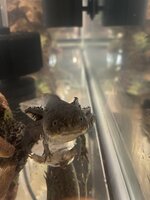victoriakallgren
New member
I have a lovely axolotl named Dragonfruit that has been in her tank since May 2021. I had to do about a 90% water change on her tank to move it from the stand that broke to a new stand. Since I was in a major hurry to move the tank before it fell from the table, I didn’t save any of the water I pulled off and then did another stupid move of not testing the city water prior to filling the tank. When it rains heavily here our city water switches from mountain runoff to well. With the well water comes much higher ammonia and chlorine levels. I use Prime to treat the water. Testing the water after treatment with a API freshwater master test kit, I’m getting 1.0 ppm total ammonia, 0 ppm nitrite levels, 40 ppm nitrate, and pH of 7. Her tank temperature is 66.4 degrees F during the day and about 61 to 62 degrees F at night.
Is it safe to put her back in the tank with ammonia levels that high? How badly is this going to throw off the nitrogen cycle? I don’t have any live plants in the tank at the moment because my green thumb is black. If plants would help, what do you recommend?
Is it safe to put her back in the tank with ammonia levels that high? How badly is this going to throw off the nitrogen cycle? I don’t have any live plants in the tank at the moment because my green thumb is black. If plants would help, what do you recommend?

